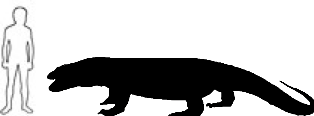MEGAFAUNA
The term ‘megafauna’ means big (MEGA) animals (FAUNA). When we say big, we actually mean giant! Picture giant kangaroos and wombats, huge birds, snakes and lizards. These ‘giants’ were at least 30% larger than their modern day cousins. Australian megafauna evolved after dinosaurs became extinct some 66 million years ago. They lived for around 11 million years and died out in a mass extinction about 46,000 years ago.
Eulo Megafauna and Microfauna Fossil Discoveries
Some ten species of Megafauna have been found in the remote southwest town of Eulo. The most common is the Diprotodon, meaning ‘two forward teeth’; a giant marsupial resembling a bear. Given the impressive title as the largest known marsupial to have ever lived, its closest modern day relatives are the wombat and koala. They’ve also found tiny fossils (microfauna) from species of fish, frogs, lizards and small mammals.



Megafauna species represented to date include:
Microfauna
Many examples of microfauna are also being uncovered on the same site including:
- Fish
- Chelid turtle
- Myrid rodents
- Echidna
- Eastern bearded dragon
Plant fossils from the time have also been recovered. These will provide an indication of climate.







